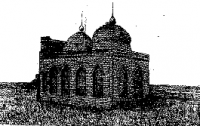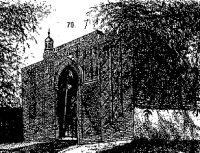You are here
History of mausoleum of Karakhan.


Popular destinations to Taraz.
“This Mazar, with a failed dome, has an entrance from the south side, and the tomb has a direction from south to north. In my opinion, this mazar deserves attention for its ancient architecture. I have long begun to collect information from local residents about Karakhan and Mazar Aulieat, but I managed to collect very little”
Local historian V.A. Kallaur.
Excursion to mausoleum of Karakhan.
The ingenious creation of ancient Taraz - the medieval mausoleum of Karakhan, admired its beauty connoisseurs of architecture of the late XIX century. Folk legends connect the construction of the mausoleum with a man, the ruler of the city during the period of Islamization of the region.
His name is not known for certain, but one thing is clear - he was the khan of the Karakhanid dynasty, who ruled in this region in the X - XII centuries. The local name for the mausoleum of Auliye-Ata was called the mausoleum, which kept legends and tales of the Holy Elder.
By this name - Aulie-Ata - in the middle of the XIX century. the revived city began to be called on the ruins of ancient Taraz, preserving the ancient heritage of its former power. Unfortunately, the medieval mausoleum was not preserved in its original form, until the beginning of the twentieth century. the monument came in dilapidated condition.
In historical and archival sources, information about the reconstruction of the medieval mausoleum is very stingy, where only the date of construction of the mausoleum is given - 1905 - 1906, the same date is marked on an epigraphic carved cartouche at the entrance to the mausoleum.
Since the inhabitants of the city considered the mausoleum the burial place of the "saint" they could not accept the fact that the walls and the dome of the mausoleum were dilapidated from time to time. According to the old-timers of the city, Tashkent architects were engaged in the restoration of the mausoleum, who built a typical example of Central Asian religious architecture on a medieval foundation. During perestroika, unfortunately, the medieval decorative facade design was irretrievably lost.
Only a few surviving terracotta bricks embedded in the wall of the mausoleum and a few archaeological finds on the territory of the historical and cultural complex can tell us about the rich rich decoration today. However, written sources and photographs of the late XIX century captured the unique architectural and spiritual heritage of the ancient city of Taraz.
Information about the mausoleum of Karakhan came to us thanks to the rarest records, photographs and drawings of the first researchers - historians, ethnographers and local historians, who were members of the Turkestan circle of archeology lovers.
This is how the first researchers captured the medieval mausoleum of Karahan:
The head of the Auliye-Ata district, the tireless local historian V. A. Kallaur, in a message about the mazar Auliye-Ata wrote: “This mazar, with a failed dome, has an entrance from the south side, and the tomb has a direction from south to north. In my opinion, this mazar deserves attention for its ancient architecture.
“For a long time I began to collect information from local residents about Karakhan and about the mazar of Aulieat, but I managed to collect very little.” (see: Protocol of the meeting of the general meeting of members of the Turkestan circle of archeology lovers. May 5, 1897).
The historian and bibliographer of Central Asia V.P. Pankov at a meeting of the Turkestan circle of archeology enthusiasts held on May 5, 1897 in an article entitled “Mazar of Karakhan” provided a complete visual description of the monument and collected information about Karakhan from an old-timer.
Today it is unique historical data: - “... the mazar of Karakhan, formerly near Auliye-ata, at the entrance to the city from Tashkent, and now within the urban population, near the Russian church, not far from the street along which you have to enter Auliye -at, on the right side.
At the entrance, it is not particularly striking, firstly, because it stands behind the trees, and secondly because it faces the street with its back side, which is very blurred and destroyed from time to time. On it, only two of its minarets, decorated with colored glaze, are well preserved, which only catch the eye when entering the city.
On the front side, this antiquity has an impressive appearance and now, although time has taken away from it many of its graceful, apparently, ornaments. But what is especially worthy of attention is the correctness and symmetry of a building made of beautiful Chinese brick.
Both minarets are standing at the corners on the front side of the monument, as poured into one shape. Restoration, as you can see, over the past century, the monument has not been Only the doors are not ancient.
From top to bottom on the doors are the latest Muslim inscriptions of pious visitors and worshipers of the saint, in the form of prayers and sayings... Pankov noted that on the facing bricks there are geometric patterns in the form of squares and circles.
The height of the facade of the monument was 12 - 13 m, which was the tallest building in the city. The monument is located in the middle of a vast, fenced in, Muslim cemetery. Pankov on the basis of a survey of legends with local residents gives the name of the ruler - “St. Khazreti-Aulie was known among the people under the name of Karahan; but his real name was Sha Mahmood.
Is he He lived not in the white light for 95 years, of which 15 years he shone to God, being constantly in prayer and fasting and not showing himself to the people, but he ruled the people for 40 years.. ” The date of death and the genealogy of Karakhan was recorded by Pankov from the words of the Aulieati casiy Abdullah:
“Sha-Mahmud, i.e. Karahan, died in 866 AD, or 1031 a year ago. His family tree, the prophet’s son-in-law, is Khazreti-Ali, Muhammad Khayafiya, Sha-Abduftgah, Sha-Abdujabbar, Abdukahar, Sha-Hassan, Abdul-Azis and finally Sha-Mahmud. " (see: Protocol of meetings of the general meeting of members of the Turkestan circle of archeology lovers, May 5, 1897)
Joseph-Antoine Castañe - an oriental historian specializing in Central Asia in his work “Tombstones of the Kyrgyz steppes” describing the Central Asian mausoleums left a note - “this monument is built of Chinese bricks (the so-called researchers burnt medieval brick - K. A.) with two openwork minarets of glazed bricks on the sides.
Despite the hardships of the time, he still retained his grandeur. Its facade is slightly hidden by trees. This part is the best preserved and most interesting. Some of the front wall drawings look like a cross. According to legend, this grave contains the remains of a Uigur or Karluk prince, who was the first of the ancient Turks (Türks - K. A.) converted to Islam”
Such a magnificent architectural monument included the mausoleum of the ruler of the Karakhanid dynasty in scientific literature. The ingenious creation of medieval architects was subject to destruction by time, but preserving the medieval architectural style and rich decorative design.


Literature.
The set of historical and cultural monuments of the Republic of Kazakhstan. Jambyl Region. Almaty. 2002 with. 87.
Historical and cultural monuments of Kazakhstan. Minutes of meetings of members of the Turkestan circle of lovers of archeology. Turan, 2011 from 420 - 421. Ibid., From 422 - 423.
A. Castan. Tombstones of the Kyrgyz steppes. Orenburg, 1911 59-60.
Authority:
Senior Researcher, State Monument Museum “Ancient Monuments of Taraz” Krokoshev A. V. http://www.drevniytaraz.kz







